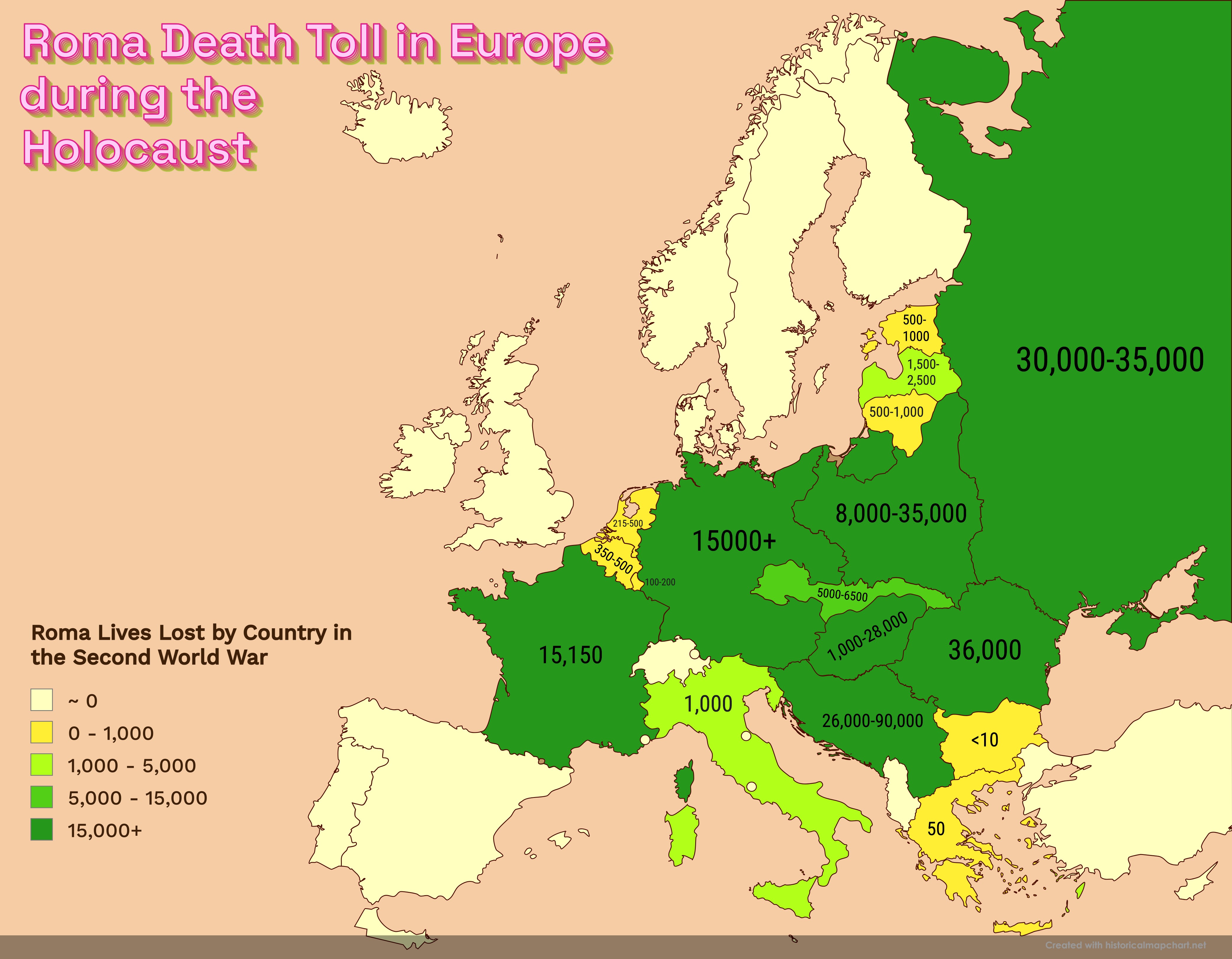Roma Death Toll in Europe during the Holocaust Map


Marcus Rodriguez
Historical Geography Expert
Marcus Rodriguez specializes in historical cartography and geographic data analysis. With a background in both history and geography, he brings unique...
Geographic Analysis
What This Map Shows
This powerful visualization highlights the estimated death toll of Roma people across various European countries during the Holocaust. It serves as a somber reminder of a tragic chapter in history, specifically focusing on the systematic persecution and genocide of the Roma, also known as Romani people, who were targeted alongside Jews and other marginalized groups. By illustrating the estimated fatalities in different nations, the map provides a stark visual representation of the scale of suffering endured by the Roma community during World War II.
Deep Dive into the Roma Holocaust
The Holocaust remains one of the darkest periods in human history, marked by the horrific genocide perpetrated by Nazi Germany and its collaborators. Interestingly, while much attention has been given to the Jewish experience during this era, the plight of the Roma has often been overshadowed or overlooked. The term "Porajmos," meaning "the devouring" in Romani, is used to describe the genocide of Roma people. Estimates suggest that between 220,000 and 1.5 million Roma were killed during the Holocaust, with the exact number still debated among historians due to the chaos of the war and the lack of proper records.
The Nazis viewed the Roma as racially inferior and sought to eliminate them along with other groups they deemed undesirable. This persecution was not limited to Germany; it extended across Europe, affecting countries like Hungary, Romania, Poland, and the former Yugoslavia. Each country faced different circumstances and levels of brutality, leading to varied death tolls.
Interestingly, the map shows that the highest death tolls were recorded in countries like Romania and Hungary, where the Roma population faced extreme violence and deportations. For instance, in Romania, nearly 11% of the pre-war Roma population was exterminated, while Hungary saw a significant number of Roma sent to concentration camps, where many perished from forced labor and horrific living conditions.
Moreover, the Roma were often subjected to forced assimilation policies even before the war, making them vulnerable to Nazi persecution. This context is crucial in understanding the depth of the tragedy. The Romani were routinely marginalized in society, often facing discrimination and violence, which made them easy targets during the Holocaust.
Regional Analysis
When we break down the map by region, it becomes clear that the impact of the Holocaust on the Roma community varied significantly across Europe. In Western Europe, countries like France and Germany had varying estimates of Roma deaths, with about 25,000 and 20,000 respectively. However, in Eastern Europe, the numbers soar, with Romania and Hungary facing the most devastating losses.
For example, in Romania, the government collaborated with the Nazis, leading to mass deportations and executions of Roma. In contrast, countries like Italy and Spain had smaller Romani populations, resulting in lower death tolls. However, even in these countries, the Roma faced persecution and discrimination. Interestingly, the map reflects these nuances, illustrating the complex narrative of the Roma experience during the Holocaust.
The former Yugoslavia also presents a compelling case. The disintegration of Yugoslavia during the war led to chaotic conditions, making it difficult to track the fate of the Roma. However, it is estimated that tens of thousands were killed or went missing, a tragedy compounded by the lack of acknowledgment in historical narratives.
Significance and Impact
Understanding the death toll of Roma during the Holocaust is crucial for several reasons. Firstly, it emphasizes the importance of recognizing the diverse experiences of all marginalized groups during this period. The Roma genocide is not just a historical footnote; it is a stark reminder of the consequences of intolerance and prejudice.
Moreover, this topic has contemporary implications as well. Today, the Roma community continues to face discrimination and social exclusion in many parts of Europe. By remembering the past and honoring the victims, we can better advocate for the rights and dignity of Roma people today. This remembrance is especially poignant on Roma Holocaust Remembrance Day, August 2, which commemorates the thousands of Roma who perished during the Holocaust.
As we reflect on this map and the history it represents, it’s important to foster dialogue and awareness about the challenges the Roma face today. Have you noticed the ongoing struggles of marginalized communities in your region? Understanding the past can help guide us toward a more inclusive future, ensuring that history does not repeat itself.
In conclusion, the Roma death toll map is not just a visual representation of statistics; it is a powerful reminder of the lives lost and the ongoing fight for recognition and rights for the Roma people in Europe. By engaging with this history, we honor their memory and commit to a more just and equitable society for all.
Visualization Details
- Published
- August 2, 2025
- Views
- 128
Comments
Loading comments...